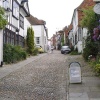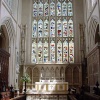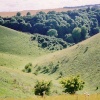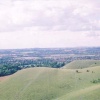Please login or click here to join.
Forgot Password? Click Here to reset pasword
 |  |  |  |  |  |
| Edward Lever Posts: 734 Joined: 22nd Dec 2005 Location: UK | quotePosted at 12:11 on 16th November 2015 In the process of taking a landscape shot hand-held on a gloomy English winter day, I found I was struggling for enough light to achieve a decent shutter speed, which would be fast enough to minimise camera shake. It started me thinking how often we forget about shutter speed, now that many people, including myself, often leave their cameras on auto (although many digital cameras have that 'shaky hand' warning). In the old days of 35mm film, the 'rule of thumb' when hand-holding the camera was to aim to set the shutter speed faster than the reciprocal of the focal length of the lens Therefore if your lens was a standard 50mm, then the slowest shutter speed you could reasonably use without too much camera shake was 1/50 second. One had to hope that the lens was fast enough and/or the film in the camera was fast enough to cope with the available light. Now that most of us use digital cameras, the rules have changed: 1) The digital sensor is generally smaller than full-frame, so that the crop factor of the sensor must be taken into account, so for the example of a 50mm lens on a 1.6 crop sensor camera, the effective focal length becomes 80mm and the minimum hand-held shutter speed is 1/80 second. 2) Technology has given us variable ISO settings so that if the light is poor, one can crank up the ISO, albeit with increased noise, to get a decent shutter speed. 3) Many cameras and lenses now have Image Stabilisation (IS) so the old 'rule of thumb' no longer applies, and shutter speeds can typically be set up to four times longer than they would without IS (unless of course you need a faster shutter speed to 'freeze' the action in a sports shot). Obviously if one is using a zoom lens, then the shutter speed obtained from the old 'rule of thumb' must be derived from the actual focal length in use. |
| Rod Burkey Posts: 554 Joined: 2nd Sep 2008 Location: UK | quotePosted at 16:45 on 16th November 2015 I tend to use aperture priority with my trusty Nikon. However, it's well worth while opting for shutter priority, which will help control things in dull light as you've already chosen a "safe" speed. Modern DSLRs can cope well with pretty high ISOs before "noise" becomes a factor. I generally use aperture priority when depth of field is paramount, and shutter priority when movement comes into the equation. Using the auto settings tends to make it all a bit more "sterile", but that's my own subjective view. If I'm in the mood, I also use manual settings to achieve something a little more "considered". I always use manual settings in a studio. I never use auto, but if I snatch a shot, program mode can deliver well. Good to see a photography thread. Cheers Edward!
|
| Ron Brind Posts: 19041 Joined: 26th Oct 2003 Location: England | quotePosted at 17:36 on 16th November 2015 Yes to the photography thread from me also Edward, well done! |
| Edward Lever Posts: 734 Joined: 22nd Dec 2005 Location: UK | quotePosted at 07:49 on 17th November 2015 On 16th November 2015 16:45, Rod Burkey wrote:
If the camera is set to Aperture Priority, my usual choice for landscapes, poor light will force the shutter speed lower, and this is where some judgement comes into it, in deciding how low to go before camera shake sets in. As you say, Shutter Priority is the mode for freezing action. I haven't done much Sports Photography, but when I do, I select Shutter Priority and set the shutter speed to 1/1000 second or faster. With such fast shutter speeds, it is possible to run out of light even with the lens wide open, which explains why professional sports photographers use such whopping pieces of glass. |
| Please login to post to this thread... |